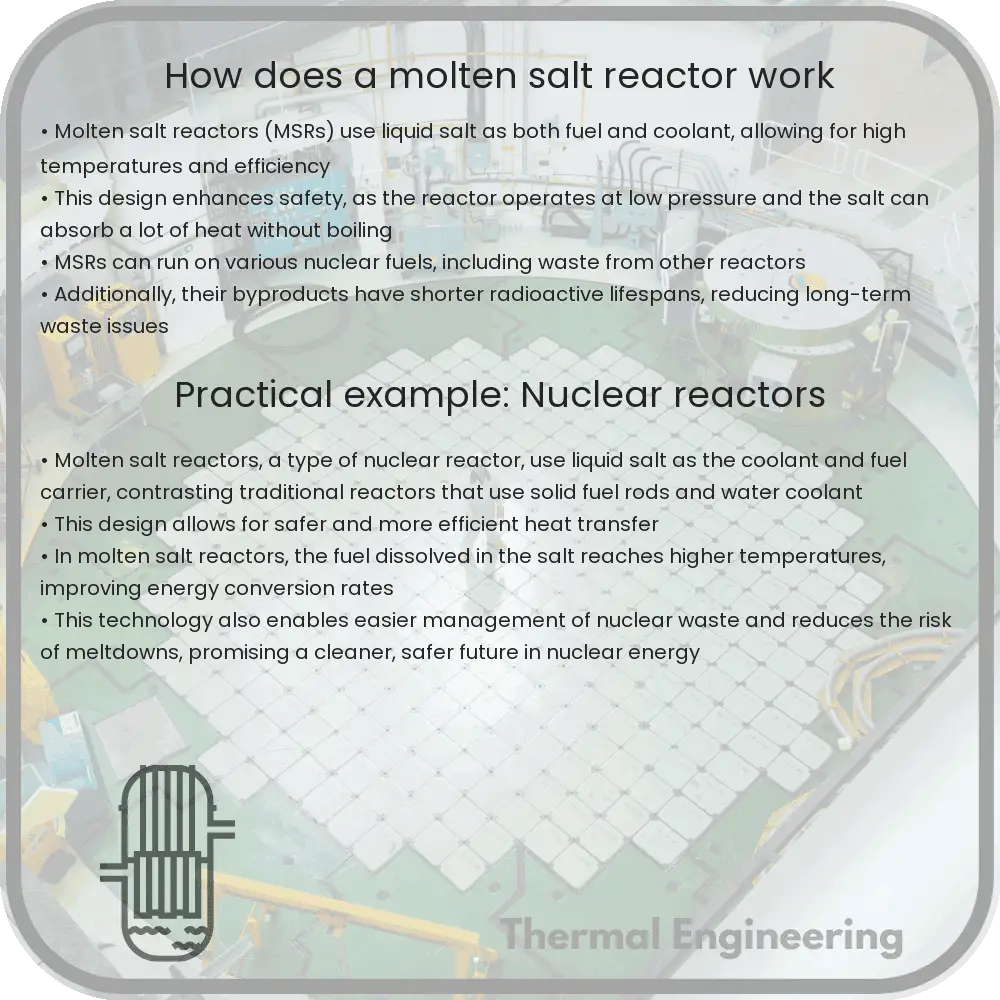Learn about molten salt reactors (MSRs), nuclear reactors using molten salt mixtures for coolant or fuel, enhancing safety and efficiency.

Understanding Molten Salt Reactors
Molten salt reactors (MSRs) are a type of nuclear reactor where the primary coolant, or even the fuel itself, is a molten salt mixture. They offer several advantages over traditional nuclear reactors, such as higher thermal efficiencies and inherent safety features. Understanding how these reactors work is key to appreciating their potential in the future of energy production.
Core Components and Functionality
The basic operation of a molten salt reactor begins with its most central component: the liquid fuel. Unlike conventional reactors that use solid fuel rods, MSRs use fuel dissolved in molten salt. This fluid not only acts as the fuel but also serves as the coolant.
- Reactor Core: The core of an MSR contains a mixture of molten fluoride or chloride salts. These salts can operate at high temperatures without turning into a gas and have excellent heat transfer properties.
- Fuel Salt: The molten salt in the core typically contains fissile materials such as uranium-235 or thorium-232. The choice of salt and fuel depends on the reactor design and the specific application of the reactor.
- Heat Exchanger: The hot molten salt is circulated through a heat exchanger where it transfers its heat to a secondary coolant. This heat can then be used to produce steam, driving turbines and generating electricity.
- Pump Systems: To keep the molten salt circulating through the reactor core and the heat exchanger system, robust pumping systems are necessary due to the high temperatures and corrosive nature of the salts.
Neutron Moderation and Fuel Cycle
Neutron moderation is a critical aspect of controlling the nuclear fission process within any reactor. In molten salt reactors:
- Moderator Materials: Materials like graphite or heavy water are often used to slow down the neutrons produced by fission. Slow neutrons are more likely to induce additional fission events, maintaining the nuclear chain reaction efficiently.
- Thorium Fuel Cycle: Some MSRs are designed to utilize a thorium fuel cycle, where thorium-232 absorbs a neutron to become uranium-233, which is fissile. This cycle is particularly appealing because of thorium’s abundance relative to uranium.
Safety Features
Molten salt reactors are considered inherently safe for several reasons:
- Negative Temperature Coefficient: As the reactor heats up, the efficiency of the nuclear reaction decreases, automatically controlling the reactor’s power output and preventing overheating.
- Freeze Plug: A key safety feature in many MSRs is a freeze plug made of solidified salt. Located at the bottom of the reactor vessel, this plug will melt in the event of a critical failure, allowing the molten salt to drain from the core into a passive cooling tank below, effectively stopping the reaction.
- Chemical Stability: Unlike water, molten salts do not boil off or produce high pressures under the operating temperatures of an MSR, reducing the risk of a pressurized explosion.
Advantages Over Conventional Reactors
In comparison to traditional nuclear reactors, molten salt reactors offer several significant advantages:
- Higher Operating Temperatures: This means they can achieve greater thermal efficiencies, potentially reaching up to 50% with advanced designs compared to about 33% for traditional water-cooled reactors.
- Reduced Waste: MSRs can potentially reduce nuclear waste through more efficient fuel utilization and the capability to breed their own fuel.
- Versatility: They can be designed for different applications, from large-scale power generation to small, modular setups ideal for remote areas or developing nations.
Molten salt reactors represent promising technology in nuclear power’s future, offering a combination of safety, efficiency, and sustainability. As research continues and technologies improve, MSRs could play a crucial role in meeting the world’s increasing energy demands while minimizing environmental impact.